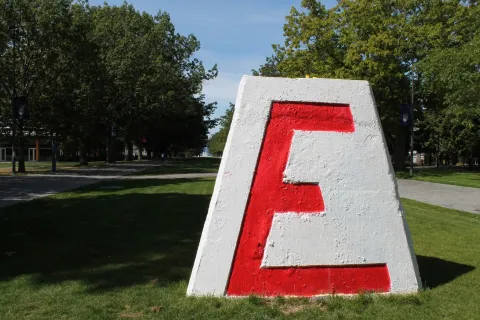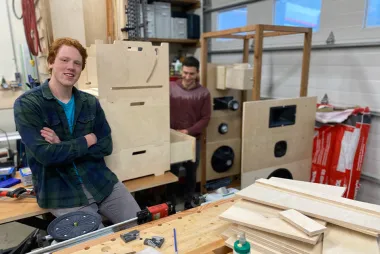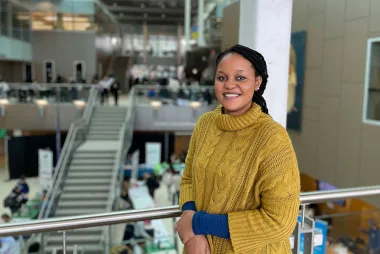UBC Engineering set record high for student work placements in 2021

Last year, UBC Engineering students secured the highest number of work terms in the UBC Applied Science Co-op program's history. The achievement suggests that UBC continues to be a top choice for employers seeking engineering talent.
The co-op program reports that after a decline in job placements in 2020 due to the COVID-19 pandemic, it saw a total of nearly 2600 student work terms in 2021 — a seven per cent increase relative to 2019.
Intel, Ledcor, BC Hydro, Microchip and Verathon Medical were among the organizations that hired the most students.
"We're finding that employers are seeing the value of hiring co-op students as we transition through the pandemic," says Sara Buse, director of experiential learning and academic services at UBC's Faculty of Applied Science. At the same time, students benefit from paid technical work experiences that may shape the course of their careers.
Making connections
Civil engineering student Matt Holitzki took a position with PCL Construction, the largest general contractor in Canada, and made a significant impact at the company during his 12-month term.
Besides preparing proposals, estimating project costs and performing a variety of tasks for a major jobsite — the redevelopment of the Vancouver Post Office — Holitzki built an opportunity tracking dashboard that PCL has since rolled out on a national scale.
He also helped conduct an in-depth market analysis of a new sector of work for the company's civil team; that work is now being pursued out of Kelowna. For these and other accomplishments, Holitzki was named one of three finalists for the PCL National Student Scholarship.
"The connections I made were by far the highlight of my experience," says Holitzki, who was inspired to pursue engineering by an older cousin he looked up to as a child. "PCL provides its network of highly skilled, passionate and encouraging leaders to new employees, putting a major focus on mentorship for students.
"Additionally, on site I had the chance to connect with a wide array of individuals and to learn the ins and outs of construction from the boots-on-ground tradespeople. I'm fortunate to have remained in touch with my supervisors, and am excited to rejoin the team following my graduation."
Hands-on experience
For Aman Shah's work term, the third-year mechanical engineering student researched and developed advanced photosensors at TRIUMF, Canada's national particle accelerator centre.
The cutting-edge technology will be part of the $800 million, 250-metre-long Hyper-Kamiokande neutrino detector in Japan, which scientists will use to study neutrino oscillations with a high degree of precision.
"I assembled and tested these photosensors," he says, "which entailed CAD design of test jigs, 3D printing and scanning of updated parts, machining support structures for the sensor module and FEA [Finite Element Analysis] simulations for pressure testing. I also had to give weekly presentations to a team of 20 people around Canada and prepare a technical report summarizing my work."
Of all the interesting aspects of his role, Shah found the hands-on components particularly rewarding. "After designing a part, I had the freedom to prototype it using 3D printing and then machine some parts. Seeing my designs come to life in this way encouraged me to produce higher-quality output," he says.
It was this passion for building things — combined with an interest in "the intricate mechanisms integrated in almost every device we use" — that first set him on a path to engineering at an early age.
Support at every step
Sara Buse says one reason for the co-op program's success is the close relationships that its coordinators build with their students. Armed with a deep knowledge of various industries, they offer informed, employer-specific input on resumes and cover letters.
Co-op coordinators also help students align their job targets with their interests, and provide critical support to keep them motivated throughout the competitive search process.
"We have been offering new services and updating our current services to ensure our students have relevant information for the current job search market," adds Buse, whose team regularly reviews student and employer assessments. "For example, we have been offering technical interview practice sessions, as well as supporting job search skills during the pandemic, when jobs were less plentiful."
This term, notes Buse, the co-op team is continuing to work hard to let employers know "that our students are engineering leaders of tomorrow who bring multidisciplinary thinking skills to solve the big problems in society" — a key pillar of UBC Applied Science's strategic plan.
Elements of success
Both Holitzki and Shah credit much of their own success to the co-op program's personalized support services and extensive resources, which also include toolkits, workshops, networking events and a centralized job portal.
Aside from making use of the program's offerings, Shah encourages younger engineering students to take a proactive approach to learning. "If you do not know how something works, figure it out," he says. "Ask someone who may know, read online, take it apart if you can — but never hold back on curiosity, and never be afraid of sharing ideas. There are no bad ideas when it comes to engineering design, and the more you share ideas, the better your designs will get.
"Finally, apply what you learn! Math and physics could get boring in theory, but when you see how they apply in real systems, it makes it really interesting and helps you understand the theory better. So do personal projects, join a design team, learn by doing."
Holitzki suggests that budding engineers make time for the things that matter most to them, saying, "I've found the most success while working long hours, maintaining a strong exercise routine, eating healthy and promoting positive relationships with friends and family."
He also suggests stepping out of one's comfort zone: "Take on extra responsibility, knock on the door of your higher-up at work to have a conversation and always leave doors open for new experiences!"


